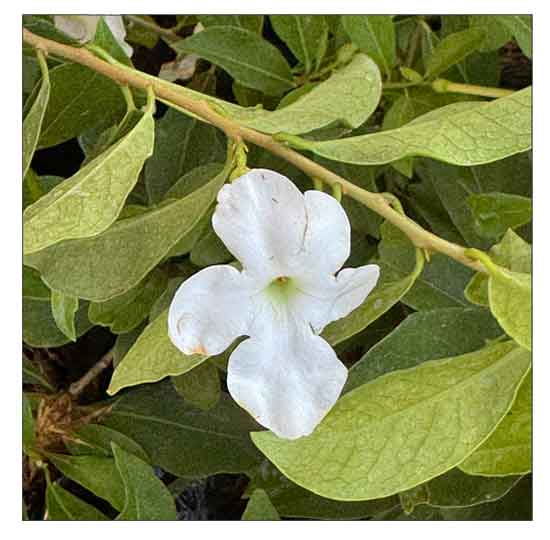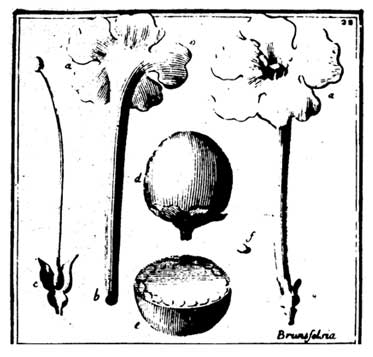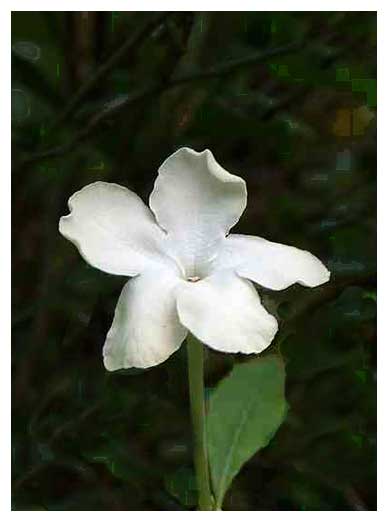| Gen
info
- Brunfelsia is a genus of flowering plants belonging to the subfamily Petunioideae of the nightshade family Solanaceae. Its 50 or so species have been grouped into three: Brunfelsia (ca 22 species), Franciscea (ca 18 species), and Guianenses (ca 6 species), which differ significantly in distribution and characteristics. The type species is Brunfelsia americana. (9)
- Etymology: The genus name Brunfelsia was named by Linnaeus honoring the 16th century German monk and herbalist Otto Brunfels
(1488-1534), who was referred to as the "Father of Botany" because of his significant contribution to botany. The specific epithet americana refers to the Americas. (9) (10)
 Botany Botany
• Brunfelsia is an erect, smooth shrub growing to a height
of 3 to 4 meters. Leaves are simple, green to yellowish-green, elliptic
to obovate, with entire margins, 5 to 10 centimeters long, pointed at both ends,
crowded on the ultimate twigs. Flowers are fragrant, terminal or axillary, solitary
or in pairs, shortly stalked, with five broad petals. Calyx is green, ovoid, 6
millimeters long and 5-toothed. Corolla tube is about 4.5 centimeters long, slender and
straw-colored; the limb is white to yellow, oblique and unequally 5-lobed,
about 5 centimeters in diameter. The fruit is rounded, about 1.5 centimeters in diameter,
with a yellow and somewhat fleshy pericarp and containing numerous seeds.
• Growth form: Fast-growing, evergreen shrub, able to grow up to 2 - 4 m tall. Flowers: Fragrant tubular flowers which will fade from white to orange-yellow after a few days of blooming, Fruit: Fruit is fleshy and will turn from green to orange when ripen. (Flora & Fauna Web)
Distribution
- Recently introduced
from tropical America.
- Cultivated in Manila and other large towns for ornamental purposes; nowhere spontaneous.
- Not naturalized.
 Constituents Constituents
- Phytochemical investigations have yielded steroids, flavonoids, tannins, and saponins.
- Yields normal fatty acids, and uncommon fatty acids such as ricinolic acid together with cyclopropenoids and normal fatty acids. (7) (5)
-
Traces of cyanide have been found the leaves, flowers, bark of stem and root. Alkaloids and chlorogenic acid have been reported from leaves and stems. (8)
- Phytochemical analysis of methanolic extract of leaves yielded steroids, flavonoids, tannins and saponins, with absence of alkaloids, terpenoids, anthraquinones and cardiac glycosides. Total phenolic content was 0.814±0.002.
(see study below) (4)
Properties
- Flowers emit a sweet scent with inebriating effects reminiscent of Brugmansia suaveolens. The fragrance emerges with the night and disappears with the dawn.
-
Considered tonic, antioxidant, anti-diarrheal.
- Studies have suggested cytotoxicity, antioxidant properties.
Toxicity
-
All parts of the plant-leaves, flowers, fruit, and sap-are reported to contain toxic tropane alkaloids that can cause vomiting, diarrhea and seizures. Cases of dog toxicosis have been reported with ingestion of Brunfelsia species (B. americana n=2). (11) All parts should be considered highly poisonous. Dogs seem especially attracted to berries and flowers; but poisoning has been reported in cats, birds and cattle who have ingested the plant. (12) In the island of Dominical, the plant is called empoisonneur, and employed as poison by the Island Caribs. (8) The tropane alkaloids are present in all parts of the plant, but mostly in the berries, which are most toxic.
 Parts used Parts used
- Fruit.
-Uses
Edibility
- No report on edibility. Reportedly toxic to humans and pets.
Folkloric
- No recorded medicinal use in the Philippines.
- In Martinique, fruit is astringent, used
as a tonic; the syrup used for chronic diarrhea. (see toxicity above)
- In French Guiana, sugary fruit made into an astringent syrup for diarrhea.
- Used for snake bites, arthritis, syphilis.
Others
- Insecticide: Reported use as insecticide.
Studies
• Cytotoxicity:
In a Bangladesh study evaluating the cytotoxicity activity 35 plant species
by the brine shrimp lethality bioassay, the methanolic extract of Brunfelsia
americana showed moderate cytotoxicity with LC50 less than 10.00 ug/ml. (2)
• Antioxidant: The presence of antioxidant activity was detected using TLC-DPPH screening. DPPH radical scavenging activity of the extract and standard ascorbic acid IC50 vales were 310 µg/ml and 200 µg/ml, respectively. Reducing power assay confirmed radical scavenging activity. Study showed high level of antioxidant activity in the plant. (see constituents above) (4)
• Unusual Fatty Acid in Seed Oil: Study of B. americana yielded ricinoleic acid together with cyclopropenoid and normal fatty acids. (5)
Availability
- Ornamental cultivation. |


 Botany
Botany Constituents
Constituents


